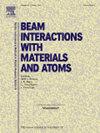Long indirectly heated cathode ion source with multi-slit electrodes for material modification process
IF 1.4
3区 物理与天体物理
Q3 INSTRUMENTS & INSTRUMENTATION
Nuclear Instruments & Methods in Physics Research Section B-beam Interactions With Materials and Atoms
Pub Date : 2025-04-13
DOI:10.1016/j.nimb.2025.165705
引用次数: 0
Abstract
We have developed a long indirectly heated cathode (IHC) ion source with a multi-slit electrodes system. With this ion source, it is possible to stably extract a sheet beam with a height of 300 mm. The beam is extracted through the four electrodes, which are composed of three slits. The current density of the extracted beam is not high. However, because the extraction aperture area is large, we can obtain a high current ion beam. In addition, by using a new developed manipulator for electrodes that can move in four directions, the beam can be efficiently passed through the electrodes. Our high current implanter installed this ion source for material modification recorded the maximum beam currents for carbon at 0.5 keV, 1 keV, and 25 keV of 32 mA, 39 mA, and 51 mA, respectively.
用于材料改性的多缝电极长间接加热阴极离子源
我们研制了一种具有多缝电极系统的长时间间接加热阴极离子源。利用这种离子源,可以稳定地提取高度为300毫米的片状光束。光束通过由三个狭缝组成的四个电极提取。所提取光束的电流密度不高。然而,由于提取孔径面积大,我们可以获得高电流的离子束。此外,利用新开发的可在四个方向上移动的电极机械手,可以使光束有效地通过电极。我们的高电流注入器安装了该离子源用于材料改性,记录了碳的最大光束电流分别为0.5 keV, 1 keV和25 keV,分别为32 mA, 39 mA和51 mA。
本文章由计算机程序翻译,如有差异,请以英文原文为准。
求助全文
约1分钟内获得全文
求助全文
来源期刊
CiteScore
2.80
自引率
7.70%
发文量
231
审稿时长
1.9 months
期刊介绍:
Section B of Nuclear Instruments and Methods in Physics Research covers all aspects of the interaction of energetic beams with atoms, molecules and aggregate forms of matter. This includes ion beam analysis and ion beam modification of materials as well as basic data of importance for these studies. Topics of general interest include: atomic collisions in solids, particle channelling, all aspects of collision cascades, the modification of materials by energetic beams, ion implantation, irradiation - induced changes in materials, the physics and chemistry of beam interactions and the analysis of materials by all forms of energetic radiation. Modification by ion, laser and electron beams for the study of electronic materials, metals, ceramics, insulators, polymers and other important and new materials systems are included. Related studies, such as the application of ion beam analysis to biological, archaeological and geological samples as well as applications to solve problems in planetary science are also welcome. Energetic beams of interest include atomic and molecular ions, neutrons, positrons and muons, plasmas directed at surfaces, electron and photon beams, including laser treated surfaces and studies of solids by photon radiation from rotating anodes, synchrotrons, etc. In addition, the interaction between various forms of radiation and radiation-induced deposition processes are relevant.

 求助内容:
求助内容: 应助结果提醒方式:
应助结果提醒方式:


